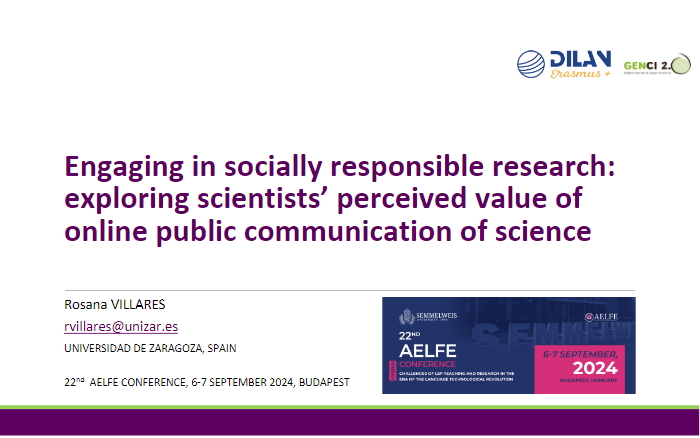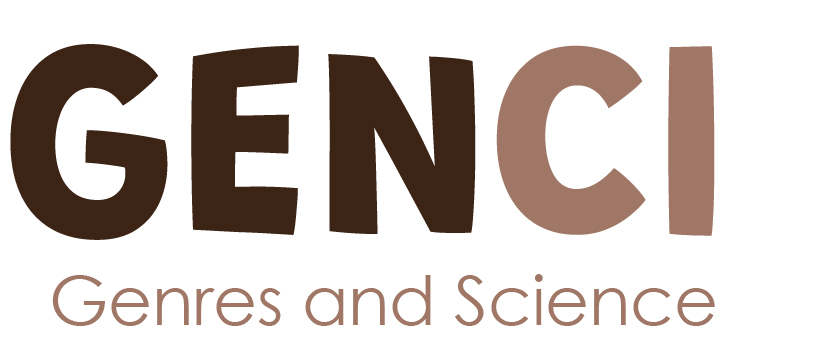In the month of September, many GENCI members participated in the 22nd International AELFE Conference, held online and on-site (Budapest, Hungary). Check some of our contributions:
1) Navigating the Digital Landscape: Mapping New Genres in Medical Research Communication for ESP Education by Marian Velilla

The proliferation of digital media has led to a significant growth in the genres researchers use to share their work and engage with diverse audiences (Luzón and Pérez-Llantada, 2022). These genres have evolved in response to demands for transparency, collaboration, and democratization of science from the Open Science movement and to increase visibility in the Attention Economy (Hyland, 2023). Research articles (RAs) have adapted to the online environment by leveraging hypertextual and multimodal features of digital media. While the RA’s structure and linguistic features have remained stable, new add-on genres like research highlights, lay summaries, graphical abstracts, visual abstracts, video abstracts and impact statements have emerged to summarize and enhance them (Coccetta, 2020; Harmon, 2019; Hartley, 2017). Medical journals, in particular, have adopted a wide range of digital genres to make research accessible to different audiences, attract attention and highlight specific aspects.
The study aims to map the repertoire of digital genres in medical journals, focusing on summary genres, to inform ESP teaching. It analyses the websites of the four medical journals with the highest impact factors in the 2022 JCR (The Lancet, The New England Journal of Medicine, JAMA, and BMJ) and examines two issues from each journal. The analysis will identify genres used to summarize and recontextualize research results. Content analysis of journal documents will provide insights into each genre’s purpose, audience, producers, and discourse features. The findings will have implications for teaching ESP to medical students in the digital age, emphasizing the importance of understanding and incorporating these new genres into their education.
Keywords: medical journals, summary genres, research dissemination, multimodal communication, ESP education
2) Engaging in socially responsible research: exploring scientists’ perceived value of online public communication of science by Rosana Villares

Check out the slides here: https://zenodo.org/records/13856438
Read the abstract: Communicating science to broad publics using the Internet and social media has become a key social priority on EU scientists’ professional agenda to enhance socially responsible research (Ball 2016). To date, little research has analysed scientists’ values and motivations regarding digital science communication practices targeted at non-specialist audiences. Using a semi-structured interview protocol, I examine Spanish female STEM scientists’ engagement in digital science communication practices. The interview data were analysed using a content thematic approach on the software Atlas.TI. Results confirm that the primary motivation for engaging in digital practices is to make science accessible to broad publics. They also view communicating beyond the scientific community as a valuable practice to improve citizens’ scientific literacy, a finding that echoes the deficit model of science communication as described by Trench (2008). In other words, scientists consider initiatives such as giving online talks, participating in podcasts, creating videos, or sharing events and content on social media (Instagram, TikTok, Twitter, LinkedIn) as an opportunity to democratise science. They also perceive them as socially responsible research, and as a way of raising awareness for scientific topics and careers (Loroño-Leturiondo & Davies 2018; Metcalfe 2019). Interviewees also highlighted the benefits of digital practices, especially after the COVID-19 pandemic, due to their international range, sustainability, and accessibility. The implications derived from the findings point to the need to design LSP training that supports skills development in communicating scientific content to non-specialized audiences on the Internet and the deployment of digital tools and resources supporting online science communication.
